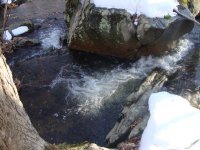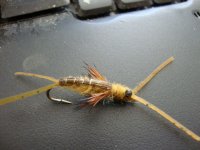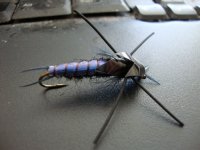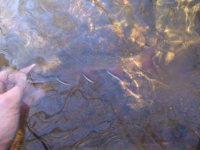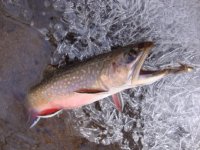k-bob
Well-known member
- Joined
- Jul 29, 2009
- Messages
- 2,371
I like dry flies, but when exploring new mountain streams in the winter, it is difficult to catch even brookies on dries in < 40 degree water. So it's hard to figure how well the stream actually fishes. I have seen some nice large stonefly larvae from a stream I like, so I thought I'd buy some evil-looking tom's stonefly nymphs and have a go at nymphing. (stonefly larvae live through the winter right?) ... I found this video, seems relevant to nymph fishing for mountain PA winter brookies:
http://www.youtube.com/watch?v=AA02MDN0XG0
OK, so I use my really-long (7'6" !) fly rod, try to high stick when fishing at close range, get a two-color strike indicator and keep it downstream of the evil looking tom's stonefly, get that fly to sink, and I'll be in Fish City. Is that right?
Would this work for brown trout even in water below 40? Do browns shows as much tendency to shut down in the sun in the winter as they do in the summer? That would make it hard to fish at higher mid day water temps.
One issue I face in the winter is glare on the water when there's snow on the ground. Even bright dries can become harder to see. That must make using a colorful strike indicator more important when there's snow and the fly line-leader junction is hard to see. Think I will also use a bright yellow fly line to help with this.
Aprreciate any thoughts...
http://www.youtube.com/watch?v=AA02MDN0XG0
OK, so I use my really-long (7'6" !) fly rod, try to high stick when fishing at close range, get a two-color strike indicator and keep it downstream of the evil looking tom's stonefly, get that fly to sink, and I'll be in Fish City. Is that right?
Would this work for brown trout even in water below 40? Do browns shows as much tendency to shut down in the sun in the winter as they do in the summer? That would make it hard to fish at higher mid day water temps.
One issue I face in the winter is glare on the water when there's snow on the ground. Even bright dries can become harder to see. That must make using a colorful strike indicator more important when there's snow and the fly line-leader junction is hard to see. Think I will also use a bright yellow fly line to help with this.
Aprreciate any thoughts...

